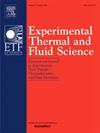利用水蒸气积分光谱带发射技术实验测量无颗粒火焰中温度和H2O浓度分布
IF 2.8
2区 工程技术
Q2 ENGINEERING, MECHANICAL
Experimental Thermal and Fluid Science
Pub Date : 2024-12-15
DOI:10.1016/j.expthermflusci.2024.111396
引用次数: 0
摘要
随着高效清洁燃烧技术的发展,无颗粒火焰越来越普遍,其温度和物质浓度分布对了解火焰结构和优化燃烧条件具有重要意义。本研究采用积分光谱带比(ISBR)方法测量了四种无颗粒氧燃烧层流扩散火焰的温度和H2O浓度分布。在实验中,采用由本文章由计算机程序翻译,如有差异,请以英文原文为准。
Experimental measurement of temperature and H2O concentration distribution in particle-free flames using water vapor integrated spectral band emission
With the development of efficient and clean combustion technologies, particle-free flames become common, and their temperature and species concentration distributions are very useful for understanding the flame structure and optimizing combustion conditions. In this study, the integrated spectral band ratio (ISBR) method is applied to measure the temperature and H2O concentration distributions in four laminar diffusion particle-free flames of oxy-combustion. In the experiments, the measurement of radiative intensity data with high spatial and spectral resolution is performed by an optical system consisting of a Gülder burner, a portable spectrometer and a translation stage. The integrated spectral emissions in two optimized bands near 1.5 μm are obtained and used to reconstruct the radial temperature and H2O volume fraction distributions of the flame cross-sections. The reconstructed results well reproduced the combustion structure of diffusion flames, and the calculated spectra using the reconstructed results are in good agreement with the measured spectra. The reconstructed results are also compared with simulation results by CoFlame code. The profiles of temperature and H2O volume fraction distributions are consistent with each other, and the biggest difference of peak flame temperatures is about 50 K. The comparisons indicate that the measured radial temperature and H2O volume fraction results have good accuracy. Path-averaged results measured by the spectrometer are also reported and compared with the radial reconstructed results. The result profiles have obvious difference, and the peak temperature is significantly underestimated in the path-averaged results with the biggest difference of 133 K.
求助全文
通过发布文献求助,成功后即可免费获取论文全文。
去求助
来源期刊

Experimental Thermal and Fluid Science
工程技术-工程:机械
CiteScore
6.70
自引率
3.10%
发文量
159
审稿时长
34 days
期刊介绍:
Experimental Thermal and Fluid Science provides a forum for research emphasizing experimental work that enhances fundamental understanding of heat transfer, thermodynamics, and fluid mechanics. In addition to the principal areas of research, the journal covers research results in related fields, including combined heat and mass transfer, flows with phase transition, micro- and nano-scale systems, multiphase flow, combustion, radiative transfer, porous media, cryogenics, turbulence, and novel experimental techniques.
 求助内容:
求助内容: 应助结果提醒方式:
应助结果提醒方式:


